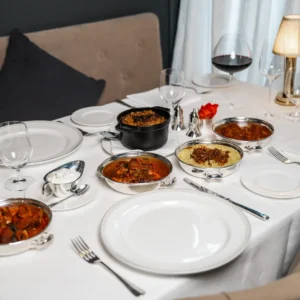Indian Fine Dining: Savouring the Flavours
Indian fine dining offers a culinary journey filled with rich history, bold flavours, and diverse regional specialities. Fine Indian dining goes beyond just eating; it’s an experience that combines taste, tradition, and atmosphere. From the use of ancient spices to modern interpretations of age-old dishes, the world of fine Indian dining offers something for everyone. In this article, we will explore the intricacies of this experience, delving into the art of Indian cuisine, the dining environment, and the cultural elements that define the essence of fine Indian dining.
The Cultural Roots of Indian Cuisine
A Heritage of Flavours
India’s culinary traditions date back thousands of years, rooted in various civilisations and empires. The subcontinent’s vast diversity is reflected in its food, where every region boasts distinct flavours, ingredients, and preparation methods. For instance, the influence of the Mughals is evident in North Indian cuisine, which features rich gravies and tandoori dishes. On the other hand, South Indian cuisine thrives on lighter, spicier fare like dosas and coconut-based curries.
The Role of Ayurveda
Ayurveda, India’s ancient system of medicine, has deeply influenced its culinary practices. The Ayurvedic principles of balancing the body’s energies (doshas) through food are still practised in many Indian households. This balance is achieved through the careful use of spices and ingredients, promoting health and wellness. Fine Indian dining often incorporates these principles, creating meals that are not only flavourful but also nourishing for the body and soul.
Regional Influences on Fine Indian Dining
North India
Northern India, with its cooler climate, favours rich, creamy dishes. Common ingredients include dairy, meats, and bread like naan and roti. Dishes like Butter Chicken, Rogan Josh, and Dal Makhani have gained worldwide fame, with their slow-cooked gravies and bold spices. The region’s use of the tandoor, a traditional clay oven, imparts a smoky flavour that elevates dishes to a fine dining level.
South India
In contrast, South India’s cuisine is lighter and spicier. Rice forms the staple, and coconut features heavily in the region’s dishes. Signature items like Dosa, Idli, and Sambar showcase the balance of flavours that South Indian cuisine is known for. Fine dining restaurants often highlight the tangy, spicy elements of Southern dishes, complemented by the use of fresh, local ingredients.
East India
The coastal regions of Eastern India are especially famous for their seafood. Moreover, fish is a significant part of the diet, and dishes like Macher Jhol (Bengali fish curry) and Chingri Malai Curry (prawns in coconut milk) clearly reflect the area’s deep love for seafood. Additionally, in fine dining settings, chefs may elevate these traditional dishes by using modern cooking techniques or rare ingredients.
West India
Western Indian cuisine includes the robust and spicy foods of Gujarat, Rajasthan, and Maharashtra. Dishes like Dhokla, Laal Maas, and Pav Bhaji have earned their place in fine dining menus for their unique use of spices and textures. Rajasthani cuisine, with its reliance on preserved ingredients due to the region’s arid climate, adds an exciting dimension to fine Indian dining.
Fine Dining Etiquette and Traditions
Traditional Indian Dining Customs
Dining in India is often a communal experience. Diners share meals, and everyone typically eats from the same dishes, using their hands instead of cutlery. While most fine dining establishments in India offer cutlery, many still encourage the traditional practice of using hands, especially when eating dishes like bread and curries. This tactile approach connects diners to the food in a deeper, more meaningful way.
The Concept of Thali
Chefs serve a thali, a traditional Indian meal, on a large plate with multiple small dishes. They typically include rice, bread, dal, vegetables, and dessert, providing a balanced and complete meal. In fine dining, chefs can transform a thali into an elaborate affair, showcasing a range of flavours, textures, and aromas. Restaurants often offer gourmet versions of thali, where chefs meticulously craft each dish to deliver a harmonious culinary experience
Presentation in Fine Dining
Indian fine dining also focuses on the presentation of food. While traditional Indian meals are often served family-style, modern fine dining restaurants emphasize plating. Chefs take great care to present dishes that are as visually appealing as they are delicious. This combination of traditional flavours with contemporary presentation enhances the overall dining experience.
The Art of Spice Blending
Importance of Masalas
Spices are the heart of Indian cuisine, and no fine Indian dining experience would be complete without them. The word masala refers to a blend of spices, and each region has its unique combination. These masalas create the depth of flavour that defines Indian dishes. A typical masala might include cumin, coriander, turmeric, and cardamom, among others. However, in fine dining, chefs often use rare and high-quality spices sourced from specific regions to elevate the dishes.
Balancing Flavours
One of the key aspects of Indian cuisine, in particular, is the balance of flavours. Furthermore, each dish must harmonise sweet, salty, sour, bitter, and umami elements. This balance is achieved through careful spice blending and, additionally, the use of ingredients like tamarind for sourness, jaggery for sweetness, and mustard seeds for bitterness. Moreover, fine dining establishments often focus on perfecting this balance, creating dishes that are complex yet harmonious.
Evolution of Indian Fine Dining Globally
Indian Cuisine in the West
Over the years, Indian cuisine has gradually made its mark on the global culinary stage. In fact, fine dining Indian restaurants can now be found in major cities around the world, from London to New York. Moreover, chefs at these restaurants often combine traditional Indian cooking techniques with local ingredients, creating a fusion that appeals to a global audience. Consequently, dishes like lobster curry and truffle naan have become symbols of this modern interpretation of Indian fine dining.
Michelin-Starred Indian Restaurants
Several Indian fine dining establishments have earned Michelin stars, reflecting the global recognition of Indian cuisine’s complexity and refinement. Restaurants like Gymkhana and Dishoom in London, as well as Junoon in New York, showcase the diversity and sophistication of Indian food. These restaurants focus on elevating classic Indian dishes while maintaining their authenticity.
Innovative Indian Chefs
Indian chefs are pushing the boundaries of what fine Indian dining can be. Many have embraced molecular gastronomy and other modern cooking techniques, creating dishes that surprise and delight diners. These chefs reimagine traditional Indian dishes, transforming them into works of art. For example, a deconstructed Samosa or a nitrogen-frozen Chai add a theatrical element to the meal, making it not just a dining experience but a sensory journey.
The Future of Fine Indian Dining
Sustainability in Indian Cuisine
Sustainability is becoming a major focus in fine dining globally, and Indian cuisine is no exception. Many fine dining restaurants are now sourcing their ingredients locally, reducing their carbon footprint, and focusing on seasonal menus. Furthermore, Indian cuisine, with its reliance on fresh vegetables, grains, and pulses, aligns well with this trend. Fine dining establishments are embracing organic ingredients and sustainable practices, creating a more eco-conscious dining experience.
Vegan and Vegetarian Options
Indian cuisine has always been a haven for vegetarians, with a wealth of plant-based dishes that are both nutritious and flavourful. In recent years, fine dining restaurants have expanded their vegan and vegetarian offerings, catering to a growing demand for plant-based meals. Dishes like Baingan Bharta (roasted eggplant) and Aloo Gobi (potato and cauliflower curry) have been reimagined in gourmet settings, providing a luxurious dining experience without the need for meat.
Conclusion
In conclusion, fine Indian dining offers a feast for all the senses. It’s not just about the food but the entire experience – from the rich history and cultural significance of the dishes to the attentive service and inviting atmosphere. Whether you’re indulging in a fragrant biryani or sipping on a refreshing lassi, every element of the meal is crafted to provide a memorable experience. As Indian cuisine continues to evolve and adapt to modern tastes, it remains a celebration of flavours that transcends borders, making it a cherished part of global fine dining.

